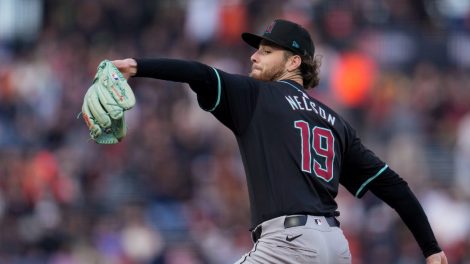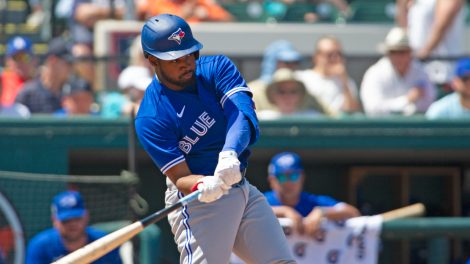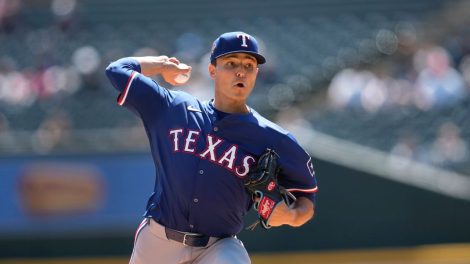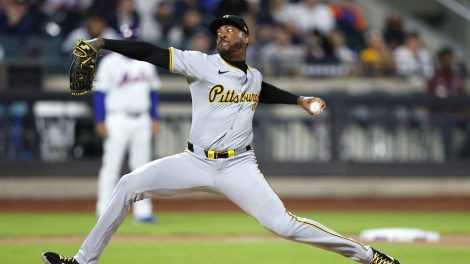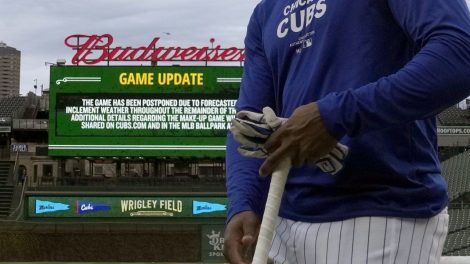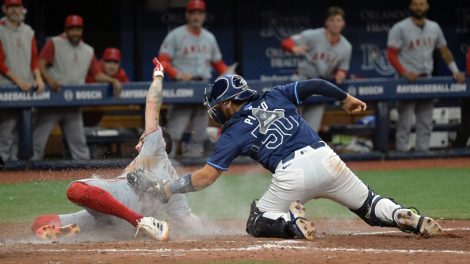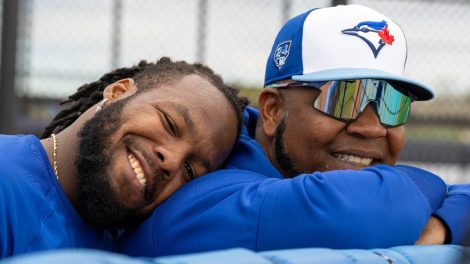LOS ANGELES – Vladimir Guerrero Jr., was looking forward to facing the Los Angeles Dodgers and the daunting trio of starters – Clayton Kershaw, Walker Buehler and Kenta Maeda – they’re scheduled to throw at the Toronto Blue Jays this week during a rare visit to Chavez Ravine.
The tweak in his left knee suffered Saturday may keep that from happening – he’s day-to-day although manager Charlie Montoyo was hopeful he’d be ready to go Tuesday night – but there should be no doubt about his will to take on a few of the game’s toughest pitchers.
“For me, it’s an honour to face these guys,” the young slugger, in comments interpreted by Hector Lebron, says during an interview before he was hurt. “I watch them on TV all the time. I’m going to go out there and try to compete, do my best and whoever wins, wins.”
Whether or not he gets to test himself against Kershaw in the series opener, more often than not over the past month Guerrero has been doing the winning. In the 26 games he’s played since July 19, he’s batting .364/.417/.657 with nine doubles, a triple and six homers among his 36 hits. He’s also walked nine times with only 15 strikeouts over 108 plate appearances, making the type of consistent offensive impact long expected from him.
Still, Guerrero’s most productive stretch in the big-leagues so far isn’t simply a result of his natural talent alone, but rather a payoff for the way he’s methodically refined his work since graduating to the big-leagues April 26.
“There’s been big-time growth since he first started,” says hitting coach Guillermo Martinez.
“It’s exciting,” says bench coach Dave Hudgens, “because when you see a young guy with that kind of talent learn how to get ready for a game, the sky’s the limit.”
Adds veteran first baseman Justin Smoak: “More than anything, now he’s got more of a routine before the game, knows how to get ready.”
This isn’t just your run-of-the-mill window-dressing.
“I actually changed my entire routine since I got to the big-leagues,” says Guerrero.
[snippet id=4722869]
***
Hudgens is familiar with this process for uber-talented young players, having served as hitting coach with the Houston Astros when Carlos Correa, George Springer and Alex Bregman transitioned to the major-leagues. Players like them and like Guerrero are so much better than most everyone else in the minor-leagues that they quickly shoot up the system, their raw ability far outpacing their experience and applicable knowledge. As a result, they get to a point where only the majors can show them what they don’t know and typically, that’s an understanding of wide-ranging and detailed preparation needed to succeed in a big-league game.
“You might be ready physically, you might be able to hit the breaking ball, and you might be able to use the whole field, but how to get ready for the game is a little different,” says Hudgens. “You haven’t developed your routines, how to game-plan. The problem with that is here, everyone is really good.”
Guerrero admits that in the minor-leagues his pre-game work was inconsistent. While he regularly did extra work, often dozens upon dozens of groundballs at third base to work on everything from his range to his throwing accuracy, not everything he did in the batting cages was as strategic. “Before he did drills just to do drills,” says Martinez, “just to swing the bat.”
At every stop in the minor-leagues, that was more than good enough. Up in the show though, pitchers picked up on his early eagerness to make an impression and nibbled around the edges of the zone, seeing if they could get him to expand. Once they discovered that they could, they kept picking away at him. “Here they can repeatedly exploit that,” says Martinez.
Eventually, Guerrero realized the way he prepared to play in the minor-leagues wasn’t going to cut it with the Blue Jays. In the most recent edition of the At The Letters podcast by colleagues Ben Nicholson-Smith and Arden Zwelling, GM Ross Atkins praised Guerrero’s open-mindedness and said, “he was asking for help, in a very confident way, not in a concerning way at all, to make subtle adjustments to his routine.”
Said Guerrero: “In the minors I didn’t have a consistent routine. Now that I’m here, I spoke with them and I feel I have my consistent routine now and I can work the way I want. Every time I come here I have to do my routine, keep working hard and everything is going well so far.”
***
On the offensive side, Martinez did a lot of the heavy lifting. A rookie in the big-leagues himself, the 34-year-old doesn’t like to push his ideas on players, preferring to ask them questions that help them get to their own answers. With Guerrero, they discussed not only creating a plan for him to take onto the field, but also some bigger picture matters, too.
“I felt like he was trying to put too much pressure on himself, especially with all the media on top of him, the fans on top of him, a 20-year-old kid trying to prove he’s the best hitter out there,” says Martinez. “So ground zero, just trying to get him back to fundamentals. Even his work has changed drastically. He’s always worked hard, but you could see the improved focus and how much more detailed the work has become since he’s been here.”
For example?
“The drill-work. The amount of reps he’s taking. The reason why he’s doing the drill,” Martinez replies. “When he changes a drill, he explains why. Now, if he fails in a drill, he continues to do it until he perfects it. There’s a competitive nature to him in the cage that wasn’t there before. I think he’s realized that he’s talented, but it can only get you so far and he has to put in the extra mental focus and physical work into his daily routines.”
As a counterbalance to the youthful Martinez is the sage veteran presence of Hudgens, 62, with his cache of been-there, seen-that experiences accumulated over four decades in the game. He hammered home another message to Guerrero.
“I told him, ‘These pitching coaches and the analytics teams, they get paid pretty good sums of money to learn how to get you out. We have to prepare the same amount of time to figure out what are they going to try to do to get me out and how are we going to counter that?’” says Hudgens.
[relatedlinks]
Guerrero adapted his pre-game cage work to include many of the off-season drills uses back home in the Dominican Republic, each with a specific intent in the batter’s box. He also started watching video of the opposing pitchers before games, something “that helps me come out here more concentrated on the pitches I’m going to be looking for.”
Defensively, he’s leaned on third base coach Luis Rivera, who is also responsible for the infielders. When Guerrero first graduated to the big-leagues, the Blue Jays played him deeper at third base, looking to maximize his range and capitalize on his strong throwing arm. As the season has progressed, they found that too many balls were getting chopped weakly in front of him so he’s been slowly moved in tighter a few steps at a time.
That led to different types of defensive drill-work at third base, and since the promotion of Bo Bichette, that’s changed again, Rivera and coach John Schneider teaming up for live-ball infield work with the duo and second baseman Cavan Biggio together.
“With the young kids, we just want to make sure they understand what we’re trying to accomplish,” says Rivera. “I think you should have a routine, no matter what. But at the same time, as we’re watching games and seeing what’s going on, we can add a little more if there’s something where you need a little more help.”
***
Not to be underestimated is the impact of watching established and respected professionals like the recently waived Freddy Galvis and Smoak go about their business. Players certainly learn from coaches, but they also learn from each other.
As the last veteran standing on the current roster, Smoak’s example is a crucial one. Few are as consistent in their routines pre- and post-game as the 32-year-old and he’s watched Guerrero’s growth closely.
“I know he was looking the other day at some video and I could tell he just didn’t feel right (at the plate),” says Smoak. “When he would do his step back, he was a little more crouched. I feel like when he’s going good, he’s a little more upright and that allows him to use his hands and his legs that much more.”
An adjustment followed and Friday against the Mariners, Guerrero hit the type of home run that player-development people would rave about in the minors, turning on an impossible pitch and sending it into the seats.
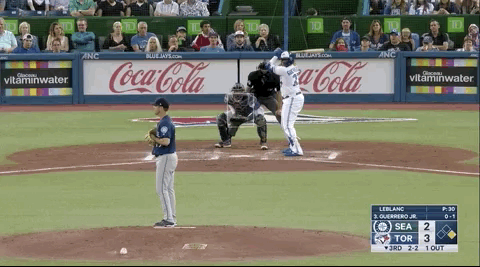
Montoyo often points to Guerrero managing to still hit .240-.250 while struggling as a sign of what’s to come from him, and Smoak echoes the sentiment. “His bat is in the zone for so long I feel like there are never going to be low lows for him, you know what I mean?” he says. “Even if he doesn’t feel good, he keeps his barrel in the zone so long that he’s going to get his knocks. When he’s hot, it’s pretty impressive.”
A 1.073 OPS over the past month is certainly that, but it’s a beginning, not an end. As Hudgens points out, “watch really professional hitters that have been in the league a long time and every part of their day is mapped out. When they eat, when they play cards or whatever they do, when they go to the cage, what they do in their BP routine, when do they look at video, all those kinds of things. That’s the process he’s going through right now.”
Already, that’s translated into better work before games, better game-planning and a more specific approach at the plate.
“I’m not really focused on what they’re trying to do to me. I’m really focused on the pitches I’m looking for,” Guerrero says of stepping into the box. “If I get the pitches I want, I’m trying not to miss those pitches. If I focus on what they’re trying to do to me, it’s going to be too much.”
Right now, all he’s doing seems just about right.



